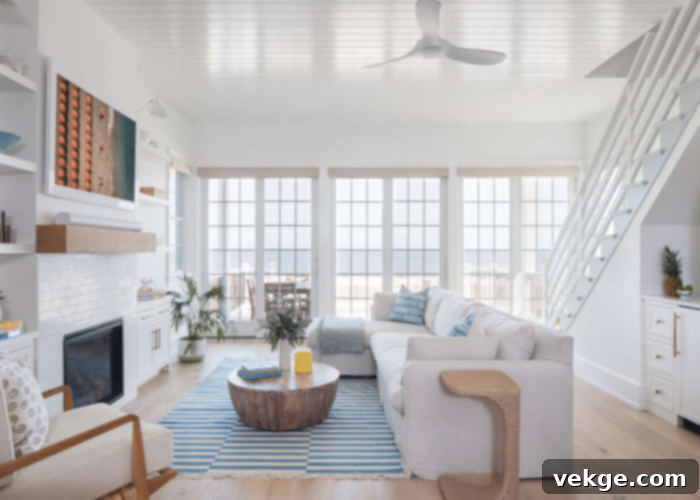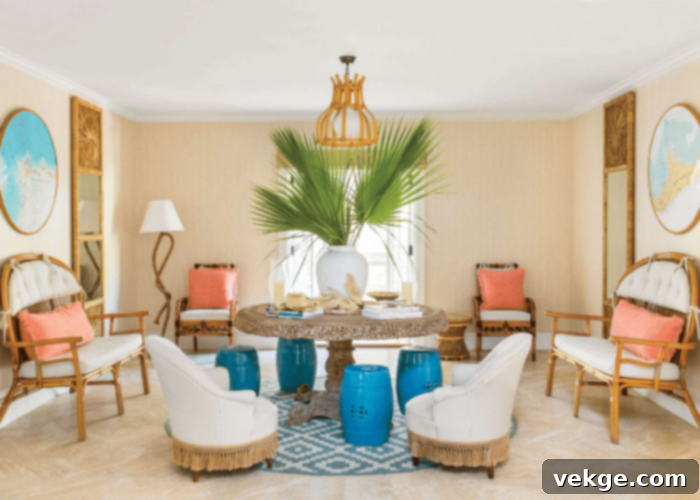Embrace Tranquility: The Ultimate Guide to Modern Coastal Design and Its Eco-Friendly Benefits
Imagine yourself unwinding in your living room, the gentle caress of a sea breeze against your skin, the distinct aroma of salty beach air invigorating your senses. The rhythmic, meditative sound of ocean waves creates a calming atmosphere, transporting you to a realm of blissful serenity. Does this sound like a dream?
Perhaps you’re longing for a touch of this captivating aesthetic and feel the urge to acquire a beach home. But hold on! You don’t need to invest a fortune to infuse your living space with the tranquil, refreshing essence of a coastal retreat. The allure of the coast can be brought directly to your doorstep, no matter your location.
Modern coastal design is quickly becoming a premier choice among those who appreciate cozy luxury and a sophisticated, laid-back atmosphere. Before you embark on transforming your home with a captivating coastal vibe, delve into this comprehensive guide. We’ll explore all the incredible details of this increasingly popular interior design trend, from its aesthetic appeal to its significant environmental advantages.
What Defines Modern Coastal Design?

At its heart, modern coastal design draws inspiration from the serene and vibrant aesthetics of coastal regions worldwide. It’s a style characterized by bright, airy spaces bathed in natural light, featuring patterns and textures that evoke the tranquility of the seaside. This design philosophy is richly influenced by the diverse spectrum of the deep ocean, incorporating shades from soothing marine blues and refreshing aqua to calming seafoam greens and elegant grays.
In color psychology, blue is widely recognized as one of the most calming and serene shades, known for its ability to promote relaxation and clarity of mind. Complementing these oceanic hues, coastal designs also integrate a significant use of earthy elements. Think of soft, sandy beige tones, warm off-whites, and creamy pearl shades that harmoniously blend with the vibrant blues, mirroring the meeting of sand and sea. Another hallmark of coastal interior design is the extensive use of natural wood, often seen in high ceiling beams, durable flooring, and handcrafted furnishings. This intentional incorporation of organic materials helps to imbue the interiors with an authentic, all-encompassing coastal essence, creating a continuous flow between the natural world outside and the comfort of your home.
However, modern coastal homes are much more than just visually appealing decor styles. A key aspect that elevates coastal designs to a necessary trend for our times is their inherent focus on eco-friendliness and sustainability. This eco-conscious approach refers to the thoughtful selection of elements that not only elegantly blend the best of the natural and man-made worlds into a cohesive space but also foster a symbiotic relationship with the environment. In essence, by embracing modern coastal design, you’re not only granting your home a stylish new aesthetic but also contributing to ecological well-being through sustainable choices, making it a design choice with genuine purpose and benefit.
Eco-Friendly Aspects of Modern Coastal Design

Having thoroughly explored the aesthetic characteristics that define modern coastal design, let’s now turn our attention to the substantial environmental benefits that accompany this style. These aren’t just superficial design choices; they represent a conscious decision to create more sustainable and healthier living environments.
1. Climate Considerate Design
Modern coastal homes often draw design inspiration from the smart, naturally adaptive architectural traditions found in Mediterranean and other nautical regions. This means a significant emphasis on open-plan layouts, deliberate outdoor seating areas, and crucially, superior cross-ventilation strategies. The thoughtful integration of these elements results in a home that inherently requires less reliance on electricity and artificial cooling systems to maintain a comfortable and pleasant interior climate. By minimizing the use of air conditioning and other energy-intensive appliances, modern coastal design actively reduces fossil fuel consumption and, consequently, your home’s carbon footprint. This approach offers a dual benefit: firstly, it positions you as an active participant in sustainable living and a change-maker for environmental preservation, and secondly, it achieves this without compromising on the elegance and sophisticated comfort you desire for your home.
2. Nature-Inspired Materials and Biophilic Elements
As previously discussed, coastal home designs fundamentally embrace the extensive use of natural, sustainable materials and elements. This commitment extends beyond mere aesthetics, focusing on responsible sourcing and durability. Consider the widespread use of rugs crafted from raw jute, renewable seagrass, or natural wool, all of which impart a warm, inviting, and inherently natural ambiance to any room. Similarly, the integration of solid, sustainably sourced natural wood for furniture, along with decorative accents like smooth river stones, polished beach rocks, and delicate seashells, perfectly complements coastal-themed interiors. This approach not only enhances the visual appeal but also maximizes the potential of biodegradable and long-lasting materials found in nature, reducing waste and supporting eco-conscious production. Furthermore, this design style aligns with biophilic principles, aiming to connect occupants more closely with nature, which has been shown to improve well-being and reduce stress.
3. Intrinsic Minimalism and Conscious Consumption
One of the most admired and inherently eco-friendly aspects of coastal interiors is their strong, intrinsic minimalist essence. The best-designed coastal homes typically feature light-toned fabrics such as serene off-white, elegant pearl, or calming beige, often highlighted with subtle accents of rich nautical shades like vibrant turquoise, deep Persian blue, or warm coral. This minimalist approach not only keeps the residents’ mood uplifted and the home’s interiors feeling balanced and serene but also deliberately minimizes the use of bright, synthetic artificial colors and excessive decorative items. We know that many synthetic dyes and materials can leach harmful chemicals into water streams and ecosystems over time. By opting for natural hues and fewer, higher-quality pieces, coastal design champions a truly sustainable approach, reducing environmental impact and promoting conscious consumption.
4. Optimally Well-Lit Spaces
This aspect is perhaps the most straightforward and profoundly eco-friendly feature of modern coastal design. Coastal homes are intentionally designed to be abundantly lit by natural daylight throughout the day. This is largely due to their predominant use of light color palettes and reflective surfaces, which significantly amplify and distribute the sun’s natural light. Even during the evening, the carefully curated ambient lighting is often sufficient to create a fully illuminated and inviting indoor atmosphere. Consequently, the need for numerous, high-wattage artificial light fittings is drastically reduced, leading to substantial energy savings. Hence, choosing a coastal-themed home offers a cost-effective, energy-efficient, and fully ambient interior decor option that also contributes positively to the occupants’ mood and overall well-being.
5. Expansive Wide Glass Windows
When envisioning modern coastal homes, large, expansive glass windows are often one of the first design elements that come to mind. As previously highlighted, a primary unique selling point (USP) of coastal homes is their exceptional ability to maximize natural light. To ensure that interiors receive an optimal influx of daylight and provide unimpeded views, wide glass windows serve as the perfect solution. Rather than requiring extensive structural redesigns, strategically placed large windows inherently fulfill this purpose. They not only enhance the feeling of openness and airiness but also visually connect the indoor living spaces with the external environment, blurring the lines between inside and out. Furthermore, when upgraded to energy-efficient options like double-pane or low-emissivity (low-E) glass, these windows also play a crucial role in regulating indoor temperatures, further contributing to energy savings and overall sustainability.
Summing It Up: Your Path to a Sustainable Coastal Oasis
So, what’s your take? Are you ready to infuse that rich, tranquil nautical vibe into your urban dwelling or transform your existing home into a serene coastal sanctuary? Let’s recap why modern coastal homes are not just a passing trend, but indeed the next significant movement in interior design. First and foremost, coastal-themed interiors offer a luxurious, relaxed Mediterranean-inspired ambiance that speaks to both comfort and sophistication.
Modern coastal interiors are meticulously crafted around accents inspired by the boundless beauty of the blue ocean and its shores. They represent an elegant and inherently sustainable interior decor option, thoughtfully incorporating the use of natural fibers like linen and cotton, sustainably sourced wood, breezy sheer drapes that invite natural light, and other eco-friendly materials into the design and decor. This thoughtful approach ensures your personal space is perpetually filled with calming, fresh energy and an enduring connection to nature.
Believe it or not, when it comes to eco-friendly home decor ideas that are both stunning and sustainable, coastal home interiors consistently rank among the top choices, offering a timeless aesthetic that’s as beneficial to the planet as it is beautiful for your home.
